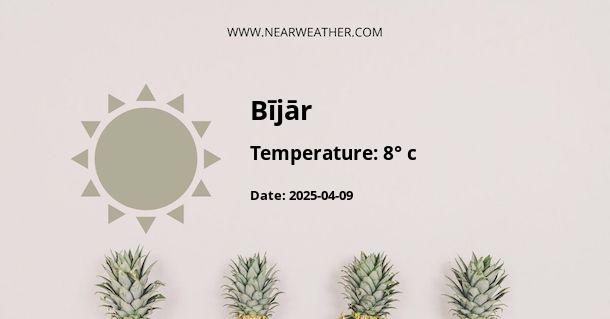Introduction to Bijar, Iran
Often referred to as the "Rug City of Iran," Bijar is a city and capital of Bijar County, Kurdistan Province, Iran. This location is known for its unique cultural heritage, historical landmarks, and more interestingly, its distinctive climate. The climatic conditions of Bijar are characterized by long, hot summers and short, cold winters, typical of a semi-arid climate.
Overview of Bijar's Climate
Bijar experiences a cold semi-arid climate (Köppen climate classification BSk). This type of climate is characterized by hot summers, cold winters, and low annual precipitation. The weather in Bijar is influenced by its geographical location, altitude, and proximity to the Zagros Mountains.
Temperature
The average annual temperature in Bijar is around 13.6°C. The hottest month is typically July, with an average high of 32°C, while the coldest is January, with an average low of -4°C.
Precipitation
Annual precipitation in Bijar averages around 382 mm. The wettest month is usually November, with an average rainfall of 58 mm, and the driest month is generally August, with an average rainfall of 1 mm.
Sunshine Hours
Bijar enjoys an average of 2,991 sunshine hours per year, which is significantly higher than the world's average of 2,000 hours. The sunniest month is typically July, with an average of 341 sunshine hours.
In-Depth Look at Bijar's Seasons
Here, we delve deeper into the four seasons in Bijar, providing a month-by-month breakdown of the weather conditions experienced throughout the year.
Spring (March-May)
Spring in Bijar sees gradually increasing temperatures, ranging from an average high of 12°C in March to 25°C in May. Rainfall during spring is moderate, with monthly averages ranging from 40-60 mm. The city also enjoys considerable sunshine during these months, with an average of 8-10 hours of daylight per day.
Summer (June-August)
Summers in Bijar are hot and dry, with average high temperatures peaking at 32°C in July. Rainfall is scarce during these months, with an average monthly rainfall of just 1-2 mm. Despite the high temperatures, the city experiences plenty of sunshine, with an average of 11-12 hours of daylight per day.
Autumn (September-November)
Autumn in Bijar is marked by gradually decreasing temperatures and increasing precipitation. Average high temperatures drop from 29°C in September to 14°C in November. Rainfall increases towards the end of autumn, with November being the wettest month of the year.
Winter (December-February)
Winters in Bijar are cold, with average low temperatures dropping to -4°C in January. Despite the cold temperatures, winters are relatively dry, with monthly rainfall averaging around 20-30 mm. The city also sees fewer hours of daylight, with an average of 5-6 hours per day.
Climate Challenges and Adaptations in Bijar
Adapting to Bijar's climate has been central to the city's development and lifestyle. The semi-arid climate necessitates efficient water management systems, and the city's architecture often reflects the need for cooling during the hot summers and insulation during the cold winters.
Conclusion
In conclusion, Bijar's climate is characterized by hot, dry summers and cold, relatively dry winters. Despite the harsh weather conditions, the people of Bijar have adapted to their environment in impressive ways. This has not only allowed them to survive but also to thrive, contributing to the city's rich culture and history.
A - Bījār's Latitude is 35.866798 & Longitude is 47.605061.
A - Weather in Bījār is 17° today.
A - Climate Conditions in Bījār shows light rain today.
A - Humidity in Bījār is 43% today.
A - Wind speed in Bījār is 9.43 km/h, flowing at 149° wind direction. today.
